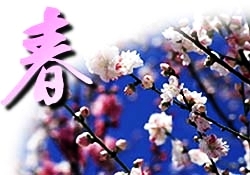| Canadian Zen Haiku canadien Vol 2 no 2 |
| editorial |
      Editors = Rédacteurs
Canadian Zen Haiku Vol. 2 no. 2 Spring = Haru 2004 ISSN 1705-4508
EDITORIAL
The Spring 2004 issue of Canadian Zen Haiku canadien, in keeping with the spirit of traditional Japanese haiku, celebrates all things natural and human revolving around one of the loveliest of all seasons, Spring. Once again, as last year, we feature a number of haikuists from around the globe, with Shigeki Matsumura, co-editor, as the featured haikuist. Without Shigeki's timely input and invaluable assistance with every issue of Canadian Zen Haiku, this new international Haiku magazine would never have been able to evolve into the world class Japanese poetry journal it has become in such a short time. Indeed, for myself, the other co-editor, the entire ongoing process of publishing each and every issue of CZH has been nothing short of a learning experience of the first order.  Spring = Haru
I confess openly that, when I started out publishing CZH in the Winter of 2003, although I had already written hundreds of haiku, or what I had deemed to be haiku, I had had little notion of what a haiku really is. Like most Westerners, I have long laboured under the impression that, in Occidental languages, which are alphabetic, and not iconic, haiku had to be composed in 3 lines of 5-7-5 syllables respectively. Nothing could be further from the truth. Traditional Japanese haiku, on the other hand, have pretty much invariably followed that pattern of 5-7-5 syllables, for the obvious reason that Japanese is not an alphabetic language at all, but is, like Chinese and many other Oriental languages, iconic. In Japanese, characters are symbols which represent not only entire words (and I emphasize, regardless of the number of syllables), but even entire concepts, which can oftentimes only be translated into Occidental linear alphabetic languages as multi-syllabic words or even multi-word phrases, sometimes even whole sentences. Hence, the 5-7-5 "syllabic" paradigm, which holds true for Japanese, completely falls to pieces when trasmigrated into Occidental alphabetic scripts.
It is primarily for this reason that the best modern anthologies of Occidental Haiku, including, as very good examples, two anthologies in this issue's "Recommended Books" column,, An Anthology of Japanese Poetry from the Country of the Eight Islands" and "Haïku sans frontières" both contain a wide spectrum of Western "Japanese" haiku adaptive styles, almost none of which adhere to the strict 5-7-5 syllabic "tradition" which all too many Western haiku dabblers blindly pursue. And this also why you will find few haiku in English, French or Spanish or any other Western language in this review which slavishly follow that 5-7-5 syllabic paradigm, for the simple reason that it cannot be accurately transposed from an Oriental character-symbol language such as Japanese to an Occidental script language.
Shigeki Matsumura adds, "As you know, Japanese haiku need to conform to the rule 5-7-5 and to containa season word. Of course, we have free-style haiku not conforming to the 5-7-5 rule, as for instance, Santoka's haiku. As far as I can see, the 5-7-5 rule is based on the peculiarity of Japanese and it is therefore impossible to apply this rule to English." This is not to say that Western language haiku should not be extremely brief, concise and pithy, as are their Japanese counterparts. They should be. You will have already noticed, I am sure, that almost all of Shigeki Matsumura's transliterations of Japanese haiku into English have either more or less than 17 syllables, and that their line lengths oscillate a great deal. On the other hand, were you to count the syllables in the original Japanese haiku, you would find that, indeed, all of the traditional ones would in fact strictly adhere to the 5-7-5 syllable paradigm. The analogy goes both ways. Shigeki continues: I tried to translate so as to convey the meaning of original haiku as faithfully as possible. Haiku is in essence one's thought and feeling telescoped into a short sentence. Being shortened and condensed, every word is often symbolic. If you were to translate the original Japanese text as it is, word by word, from Japanese to English word literally, you wouldn't understand it as Zen's dialogue. I translated by restoring the condensed contents to an ordinary longer sentence so as to facilitate understanding. In a word, my translation is appreciative and explanatory, and is thus necessarily longer than the original text. You are right in saying that haiku is ironic and humorous. It is in vain to expect haiku to be magnificent, grand and solemn by nature. For the purpose of ostentation, another poetic style, for example, Hitomaro's waka, will supply it. His waka is very grand-style. I introduced it before, though it may seem bland and featureless in translation. His best work is reflected in his Choka (Long song). Basho established haiku as art. Before Basho's time, the haiku form had appeared to the world, but it was a kind of playful game or jest, bestowed with the nature of wit, funny, comical and cutting. Basho moderated it to be humorous, and refined it to an art. Originally, Haiku has in it some of the elements of "La Raison n'est pas prolixe." The most important point in Haiku is that it must sound melodic and rhythmical. I would like to ask our readers to please read the texts of the original Japanese haiku published here, written in Romanji (i.e. with the Roman alphabet). You need not worry too much about the pronunciation. Generally speaking, haiku shys away from difficult Japanese pronunciations. For instance, in Japan, we have the hard to pronounce example, Tokyo tokkyo kyoka-kyoku (The bureau of patent permits at Tokyo). Even most Japanese people cannot pronounce it smoothly. Fortunately, Haiku is poles apart from that. NOTE ADDENDUM by Richard Vallance re. pronunciation of Romanji. As Shigeki has rightly admonished us, pronunciation of Japanese haiku is actually fairly straightforward. Pronounce every single consonant and syllable, as if you were speaking Italian. There is one major difference between Japanese and Italian or any Western language. The vowels are very, very short and closed, which is why Japanese sounds "clipped" or abrupt to the Occidental ear. I am sure most Western languages must sound like a Southern American drawl to the Japanese!
Summer = Natsu
In the next issue of Canadian Zen Haiku, Vol. 2 no. 3, Summer = Natsu 2004, we will zero in on some of the stylistic and imagistic characteristics of traditional Japanese haiku, focussing on the perceived need to transmigrate intact these poetic traits from their Japanese originals to their Western counterparts, at least where the traditional haiku form is concerned. For instance, traditional Japanese haiku almost always centre on themes and symbols derived from Nature and the natural environment, many Japanese haiku are either ironic or downright humorous, and most relegate the author to a secondary or "off stage" position, thereby allowing the haiku to shine through on its own merits. And there is much more.
Autumn = Aki
In the Autumn = Aki issue of Canadian Zen Haiku, Vol. 2 no. 4, our Editorial will focus on those characteristics of Western-language haiku which distinguish them and set them off from their Japanese counterparts. While it is undeniable that historical and contemporary Japanese haiku have consistently inspired practically all Occidental haiku, almost without exception, the socio-cultural and unique linguistic foundations of national haiku do and indeed must reflect the society and literary traditions of the nations which they represent. In a nutshell, the unique colour, flavour and tonality pervading Japanese haiku cannot be replicated in the haiku of any other nation, Oriental or Occidental, because the social-cultural and literary traditions are dissimilar. Canadian haiku are Canadian haiku, American are American, French are French, Spanish Spanish and so on, through the spectrum.
So stay tuned for our continuing editorial series on the nature of Haiku as the year progresses.
Sincerely,
Richard Vallance, Canada & Shigeki Matsumura, Japan  |
 | ||

